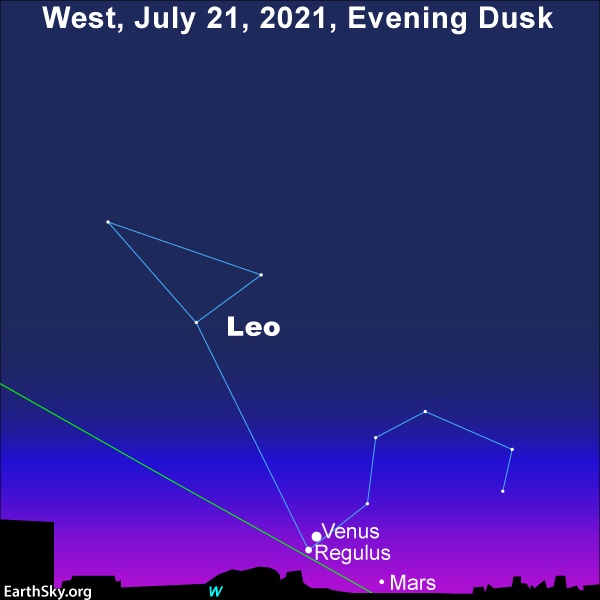
Venus and Regulus conjunction: Fun!
Watch around July 20, 21 and 22, 2021, for the blazing planet Venus to sweep by Regulus, Leo the Lion’s brightest star. Regulus represents the Lion’s Heart. Look west at evening dusk. You can’t miss dazzling Venus, the 3rd-brightest celestial object after the sun and moon. Although Regulus ranks as a respectably-bright 1st-magnitude star, this star pales next to Venus. The queen planet outshines Regulus by over a hundred times. In fact, if your sky conditions are less than ideal, you might need binoculars to spot Regulus next to Venus.
Venus and Regulus are said to be in conjunction when north and south of one another on an imaginary grid spread across the dome of sky. In this case, we’re talking about a conjunction in right ascension, which is the equivalent of earthly longitude on the sky’s dome. At the exact time of conjunction – around 19 hours UTC on July 21 – Venus passes 1.2 degrees north of Regulus. For reference, the moon’s angular diameter spans about 0.5 degrees of sky, so they are separated by approximately two full moons.
And of course we know this. Although Venus and Regulus appear close together in our sky, they’re not truly close in space. At present, Venus lodges a little less than 1.4 astronomical units (AU or Earth-sun units) from us. That’s less than 12 light-minutes away. Regulus resides far outside our solar system, at some 79 light-years distant. One light-year = 63,240 astronomical units.
Mars is below Venus and Regulus
We show Mars on the sky charts on this page. And Mars will have a conjunction with Regulus, too. The exact time of the Mars-Regulus conjunction will be July 29 at around 16 hours UTC. But this world may be tough to catch, even with binoculars. Regulus is sinking closer to the sunset, about to disappear for another season. Regulus is falling about one degree (two moon-diameters) closer to the setting sun daily. Meanwhile, both Venus and Mars are climbing upward in the western sky after sunset relative to Regulus. But Mars is descending into the sun’s glare, too. We expect both Mars and Regulus to be hard to see during their close encounter in late July.
Venus and Mars are planets of our solar system. So they shine by reflecting sunlight. Regulus, being a star, shines by its own light. The ancient Greek word planet means “wanderer.” That’s because the planets wander in front of the backdrop stars, while the stars appear to remain fixed relative to one another. Watch for the remainder of July 2021, as Venus wanders past the “fixed” star Regulus on July 21, and then Mars does likewise on July 29.

Bottom line: The Venus and Regulus conjunction will occur on July 21, 2021. Then watch for the rest of the month, as Venus wanders past this “fixed” star. Try for the Mars-Regulus conjunction on July 29, too. But by then both Mars and Regulus will be tough to spot!











